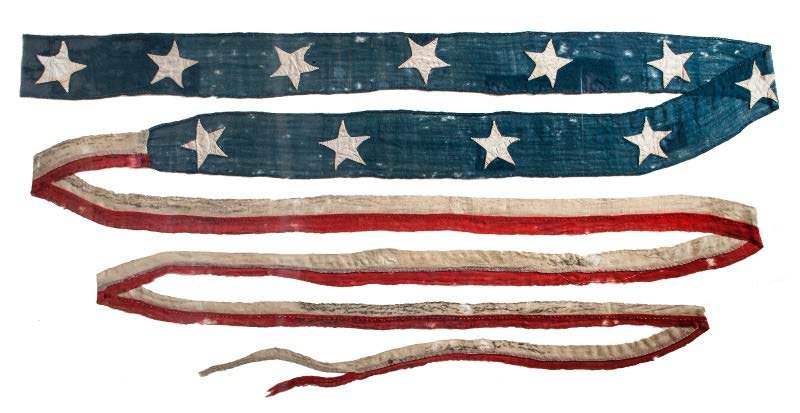
INDEPENDENCY: THE AMERICAN FLAG AT 250 YEARS
MAY 17 - JULY 19, 2025
CURATED BY JOHN MONSKY AND CHRISTINA STRASSFIELD
Monsky’s flags, represent a lifelong collection that began in his boyhood, and has since served as the focal point of his series of live multi-media musical journeys through history, which he presents at Carnegie Hall and the nation’s top performance venues. His “The Eyes of the World: From D-Day to VE Day,” performed with the Boston Pops from Boston’s Symphony Hall, is currently streaming on PBS.org.
The exhibition, combining both visual art and American history, will feature select flags and historic textiles from Monsky’s collection -- from a 1775 George Washington kerchief and a flag for the candidacy of “Abram” Lincoln to flags from the Apollo Missions, alongside Scully’s work. Insightful narrative, archival film and photography, material culture and historic documents, will enhance the visitor experience.
Photo by EJ Camp
John Monsky - Historian
John Monsky is the creator, writer, and narrator of the American History Unbound series. His reverence for historical ephemera is at the core of his productions, with his meticulous research of flags and other tangible objects driving his narratives that explore landmark events in our history. His productions at Carnegie Hall include The Vietnam War: At Home and Abroad (2018), We Chose to Go to the Moon (2019), The Eyes of the World: From D-Day to VE Day (2021), and The Great War and The Great Gatsby (2023 and 2025). Most recently, he was asked to bring his acclaimed performance of The Eyes of the World to the White House for a special performance in December 2024.
In 2019, Monsky was honored by The New York Historical, where he has developed and workshopped many of his lectures and serves as co-vice chair. He has appeared on CNN, CBS, and NBC. He is on the board of directors of The Rockefeller University and YaleUniversity Art Gallery. His flag collection—which he began in his boyhood—is nationally recognized and has been featured in The NewYorker, Art & Antiques Magazine, and other publications. His historical research on George Washington has been published by the Winterthur Portfolio.
Monsky graduated from Yale College as a history major, where he was awarded the White Prize in History and the Deforest OratoryPrize. After attending Harvard Law School and working as a law clerk, he served as an attorney for the US Senate Congressional Committee that investigated the Iran-Contra affair. Monsky, a historian and lawyer, is a senior partner of Oak Hill Capital, an investment firm. He lives in New York City with his wife, Jennifer Weis. They have four children—Harrison, Annabel,Gillian, and Caitlin—and a dog, Flyer.
“These flags reflect our history, tell our story. Flags that were at rallies, battles, celebrations – flags that were present at hope-filled moments and flags that flew during moments of tragedy. It is also important to appreciate the flag as a geometric object. Its creation was an artistic act. The field of stars calls to our dreams, but it can also be seen as a remembrance of those we have lost: the boys on Omaha Beach on D-Day, dreamers like Amelia Earhart, the astronauts who died in their effort to explore space. The stripes can be seen as the oceans that Americans sailed and the fields where they plowed. We look at the flag every day, but rarely do we contemplate its design and the moments its design captures.”
- John Monsky
-
An introduction to the role flags have played in our history, the artistry of the stars and stripes, and the use of that geometry in art, with resonant work from renowned abstract artist Sean Scully.
-
Campaigns, Parades, and Political Expression: An examination of the role flags and kerchiefs have played in politics and civic discourse, including Presidential campaigns of Abraham Lincoln, John Quincy Adams, and Ulysses S. Grant. Work from Scully continues to interact with the geometries of the textiles.
-
Vietnam and the Moon: A look at flags reflecting one particularly complex moment, including a tattered flag from a Swift Boat, its occupants 20-year-old boys, juxtaposed with a “Love” flag from San Francisco circa 1968. America’s passion for exploration is seen through textiles from the Wright Brothers and Amelia Earhart, as well as flags that went to the surface of the moon.
-
Sacrifice: This collection of flags reflects the victory and heartbreak of America’s conflicts. Highlights include a pennant flown by the USS Constitution in the War of 1812, the conflict which gave us The Star-Spangled Banner, the flag carried by the nearly all-Black 25th Corps, that captured Richmond, Virginia, the capital of the Confederacy, General George Patton’s personal guidon, and flags that landed on the Beaches of Normandy on June 6, 1944. More contemporary flags are from a memorial held for those who died on Flight 93 on 9/11, and one carried by a US Navy Seal in Afghanistan.



